IDEX Online Research: Global Diamond Prices Stuck in a Rut
October 04, 09
Global polished diamond prices seem to be stuck in a very narrow price range. There is certainly not enough demand to push prices higher, and while they haven’t moved lower, our sense is that any minor shock or surprise could send polished diamond prices skidding lower.
The IDEX Online Polished Diamond Price Index averaged 108.56 during September, slightly below August’s 108.67. For the past six months – since April – polished diamond prices have languished between 108.5 to 109 on the IDEX Online Index.
Unfortunately, there is no catalyst on the horizon to fuel higher prices. IDEX Online Editor in Chief Edahn Golan reported from Hong Kong that, “…if sales at the Hong Kong Jewellery & Gem Fair reflect the current state of the global economy, then full recovery is still ahead of us, the U.S. market is still hurting, and business in China is slower yet clearly pulling ahead.”
Further, polished prices held steady – though not really “firm” – in September despite higher rough diamond prices and attempts by polished stone dealers to implement price increases.
Now that several diamond miners have announced that they will not be closing their mines this winter, the flow of rough diamonds into the market will rise and, unlike in previous "normal" years, rough diamond supplies in the second half of 2009 are likely to be greater than those made in the first half of the year. That could have a depressing impact on rough prices. It almost certainly will have a negative impact on polished diamond prices, since cutters and polishers will want to move product at any price, as long as it generates cash.
American Market Is Key
Because the
Merchants report that there are more shoppers in malls and more customers in their stores. Further, several jewelers have said that their transaction count is up, but the average ticket is down, yielding flattish (or slightly down) same-store sales. While we view this as good news – given the extremely depressed results in last year’s fourth quarter – it simply means that the American market is at the bottom of the trough.
Until demand in the American market solidifies, global polished diamond prices will likely languish.
Unfortunately, we had hoped that the 2009 Holiday Selling Season might provide a boost to merchants’ revenues. At this point, most forecasters are predicting that total retail holiday selling season sales will be about flat with last year. We believe that jewelry sales might outpace these forecasts, if for no other reason than the math: we don’t expect sales to be below last year, and they could be ahead very modestly. This would generate a positive percentage comparison, and it would be a tremendous psychological positive.
Diamond Prices Depressed versus Last Year
The IDEX Online Polished Diamond Price Index peaked thirteen months ago at 128.91 in August 2008, and it began its free-fall from there, stabilizing in April 2009. In September 2008, the IDEX Online Index was 128.30. Since the peak in August 2008, polished diamond prices have fallen about 16 percent. Owners of stocks, bonds, and real estate wish they had been as lucky: their investments fell by as much as 50 percent, before bottoming early in 2009.
While signals from key global consumer markets are mixed – with no market showing ongoing notable declines – it is likely that polished diamond prices will at least hold more or less steady. We had hoped that there would be more encouraging signs by the early fall. Some markets such as China are signaling an economic recovery. Even the U.S. market reports that economic activity appears to be improving modestly. But other geopolitical areas around the world remain mired in weak economic conditions. Longer term, a gradual recovery of polished diamond prices will likely ensue, assuming there is no unforeseen system shock.
The graph below illustrates polished diamond prices for the past 24 months.
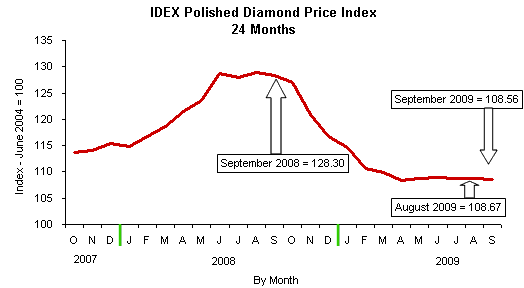
Source: IDEX Online Research
The following table summarizes the IDEX Online Global Polished Price Index since the beginning of 2007.

Source: IDEX Online Research
Month-to-Month Polished Diamond Price Trends:
September 2009 versus August 2009: (0.1 percent)
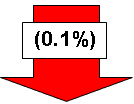 |
Further, the six-month price movement – April through September – was only a miniscule 0.1 percent, which doesn’t “move the needle” on the IDEX Online Polished Diamond Price Index. Polished prices during September showed some fluctuation: they strengthened early in the month, with the IDEX Online Index posting a reading of about 109 from September 2 through September 4. From that point, prices began to ebb very slowly, and ended the month at about 108.2.
In contrast to May when larger diamond sizes showed modest price increases and June when smaller diamond prices crept up, diamond price increases – and decreases – were mixed in September, similar to August. There was one notable price anomaly: the price of four-carat polished diamonds fell sharply, after popping higher in August. We believe that August prices for four-carat diamonds were an aberration as diamantaires attempted to boost prices for better quality larger diamonds. Unfortunately, those prices did not hold, especially after the weakness experienced by diamond traders at the Hong Kong show.
On an annualized basis, September’s polished prices indicate no inflation – or deflation – for polished diamonds. Like the stock market, polished diamond prices could test the lows of the past couple of months, but there are indications that the economy is firming in some key global markets, so there could be some support for prices. On the other hand, if a trader shouts “boo”, prices could tumble.
We believe history is a great forecaster for the future. If so, the rate of diamond price inflation would be expected rise later this year or in early 2010, especially if demand turns out to be stronger than projected. However, we continue to believe that polished diamond price inflation will return to its historic norm of about 3-4 percent annually.
The IDEX Online Polished Diamond Price Index, calculated on the average daily prices during September 2009, stood at 108.56 for the month, roughly flat compared to 108.67 for the month of August 2009. On the last day of September, the IDEX Online Polished Diamond Price Index stood at 108.19, down notably from the 108.90 level registered on the first day of the month. Unlike earlier months this summer – July in particular – when diamond prices drove the index to just over 109.00 several times during the month, the IDEX Online Polished Price Index peaked at 109.00 early in September (the same trend as in August), and then remained in a narrow range around 108 for the balance of the 30-day period. The IDEX Online Polished Diamond Price Index stood at 100.00 in July 2004.
The graph below summarizes month-over-month changes in global diamond prices for the past thirteen months. Beginning in February 2008, polished diamond prices showed large gains during every month in the first half of the year. By mid-2008, price increases began moderating. In September 2008, polished diamond prices weakened, showing consistent month-to-month decreases, a trend that continued until about April 2009.
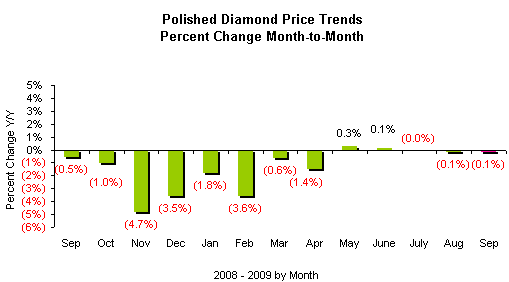
Source: IDEX Online Research
September 2009 versus September 2008: (15.4 percent)
On a year-over-year basis, global polished diamond prices dropped by 15.4 percent in September versus the same month a year ago. September was the ninth month that year-over-year prices dipped for polished diamonds. However, the decline was slightly less than August’s 15.7 percent drop. This is because diamond prices peaked in August 2008, and began to decline in September 2008. The percentage drop in diamond prices should decline over the coming months, as year-to-year comparisons become easier. 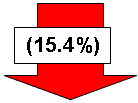
All key diamond sizes experienced price deflation in September, with large diamonds of three carat and up showing greater price deflation than smaller diamonds. This trend – larger diamond prices falling faster – has characterized global polished diamond prices for several months. Prices of those diamonds rose first and fastest in the current cycle; now, they are falling fastest.
Even if diamond prices show a recovery on a month-to-month basis, the year-over-year percentage change will continue to show deflation until late in 2009, when comparisons against 2008 prices become much easier. However, longer term, we continue to predict that polished diamond prices will return to their historical trend line inflation rate of 3-4 percent annually, perhaps in 2010.
The IDEX Online Polished Diamond Price Index averaged 108.56 in September 2009 versus 128.30 in September a year ago.
The graph below summarizes the year-over-year inflation rate by month for polished diamond prices in the global market for the past thirteen months. Comparisons are based on the daily average prices during the month versus the same month a year ago (e.g. September 2009 versus September 2008). The year-to-year comparison takes into account the seasonality of polished diamond demand and prices.
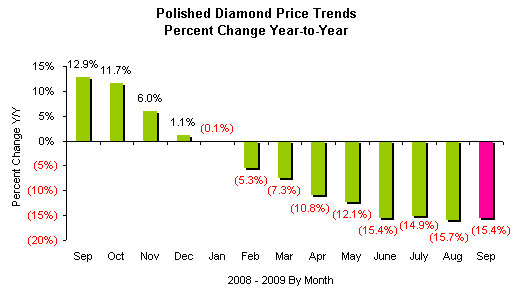
Source: IDEX Online Research
Day-to-Day Diamond Prices Generally Stable
Polished diamond trading patterns in September on a day-to-day basis reflected reasonable seasonal demand, with some price fluctuation as traders searched for pockets of demand.
The graph below summarizes polished diamond prices on a daily basis for the past three months. Some would call this trend stable; others would call it boring. We call it reassuring, since it appears that diamond prices have reached equilibrium. Short of some kind of a system shock, we believe that polished diamond prices bottomed in April in the current cycle.
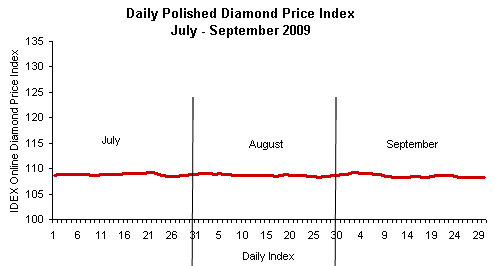
Source: IDEX Online Research
Polished Diamond Price by Size Are Mostly Steady
After rising rapidly in 2008, only to fall just as quickly at the end of the year, diamond prices by key sizes appear to have bottomed. Even more likely, we believe that they are poised to hold steady, and perhaps begin moving higher in early 2010.
During September, there were two interesting trends: four-carat diamond prices dropped, after rising in August, while five-carat diamond prices flattened out, after dipping in August. Apparently, market demand is not sufficient to sustain higher prices of these better quality, larger diamonds.
The graph below summarizes price trends since late 2006 for the seven key diamond sizes; these diamonds represent just under one-third of the total value of the trading market.
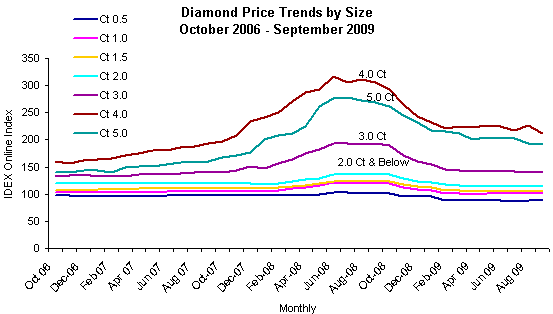
Source: IDEX Online Research
Month-to-Month Diamond Prices Mixed for Key Sizes
Compared to August, diamond prices by size were mixed in September, with some sizes showing a slight price increase while other sizes decreased in price. The sharp decline in four-carat diamonds reflects a pull-back from the prior month when prices of that size of diamond spiked unrealistically.
But here’s what is important: prices really didn’t vary much by size on a month-to-month basis.
The graph below summarizes the price changes for key sizes of polished diamonds on a month-over-month basis.
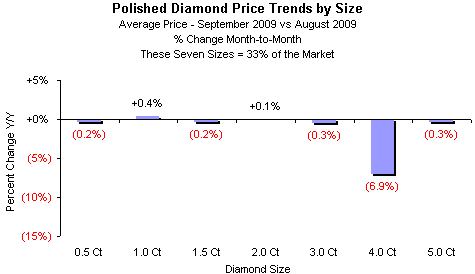
Source: IDEX Online Research
Year-Over-Year Diamond Prices for All Key Sizes Show Deflation
On a year-to-year comparison, polished diamond prices for the key sizes and qualities fell – some significantly – from the prior year. Virtually all sizes of diamonds showed a double-digit loss in price in September, though the overall decline diminished from prior months. Comparisons in September remained difficult, since there were a string of double-digit price gains for the larger diamond sizes in the summer of 2008.
The graph below summarizes polished diamond prices by key sizes on a year-over-year basis.
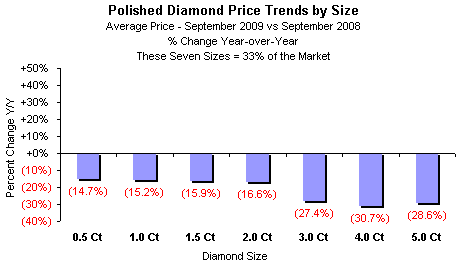
Source: IDEX Online Research
Forecast: Diamond Prices Have Bottomed in Current Cycle
We believe that month-to-month polished diamond prices will likely show flattish or perhaps modestly positive comparisons in subsequent months. As a result, year-over-year price comparisons will likely begin to show less disappointing comparisons by the early fall, in our opinion. At some point, probably in late 2010 or early 2011, we believe that diamond price inflation will recover to its historic trend line, reflecting annual inflation of 3-4 percent.
The U.S. market consumes roughly half of the world’s diamond jewelry. Its economy is showing some vitality, after significant weakness over the past year. Further, other regional economies around the globe are also showing some signs of recovery. Along with these recoveries, consumers will resume purchases of luxury goods, though at a pace below historic levels initially.
The IDEX Online Diamond Price Index
The IDEX Online Diamond Price Index is a real-time index derived from actual asking prices in the global diamond industry. The IDEX Online Diamond Price Index objectively reflects price trends as they happen. The Diamond Index and Diamond Drivers were formulated following comprehensive research and analysis of the IDEX Online inventory database, aggregated since 2001. Research and development were conducted in cooperation with Dr. Avi Wohl, Senior Lecturer of Finance at the faculty of Management, Tel Aviv University, Israel.
Additional information is available from IDEX Online Research.